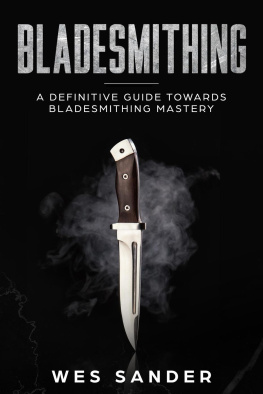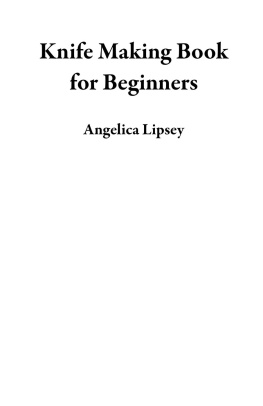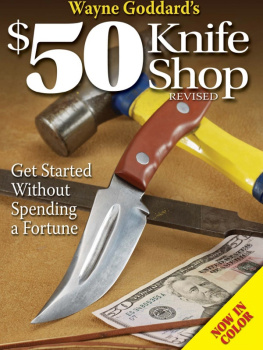Knifemaking for Beginners
A Step-by-Step Bladesmithing Guide to Forging your own Knive s with Basic Tools
Chris W. Smith
Copyrights 2021 Chris W. Smith
All rights reserved.
The contents of this book may not be reproduced, duplicated, or transmitted without direct written permission from the author or publisher.
No blame or legal responsibility will be held against the publisher or author for any damages, reparations, or monetary loss due to the information contained in this book. Whether directly or indirectly.
Disclaimer Notice:
Please note that the information within this document is for educational and entertainment purposes only. All efforts have been made to present reliable and complete information. No warranties of any kind are implied or declared.
Table of Contents
Introduction
Nearly every adult uses a knife almost every day. If not at work, then in gatherings and preparation of food.
But how many knives does one see that are genuine works of loving craftsmanship?
Very few I must say, if any.
Knife-making may strike you as a curious endeavor. With so many good knives available, you might ask yourself, why would anyone want to make one by hand? This question struck my mind when a close friend who worked in the office next to mine began talking to me about the knives he was making.
Almost every day, he would work the word knife into at least one or two conversations. His desk right next to mine always had samples of his work, used as letter openers and paperweights. I was surprised by the uniqueness of those handmade knives. They were sleek and easy to use! Handmade knives have a more mellow and personal look than commercial knives. You need not have a tremendous amount of experience in metal or woodworking to make exquisite knives!
In this book, I have decided to look at Knife-making principles from the perspective of a student, and so together, we can deal with the nervousness of using the right tools to make the-perfect-knife. This book will also cover several aspects like safety precautions you will need to observe when sharpening and taking care of your knife the right way! You'd think that making a knife needs no safety kit until you see your working space saturated with very visible dust particles!
Knife-making is an ancient art that dates back thousands of years ago. Since then, technology has advanced, making life better and more comfortable for us. We live in times where technology is continuously advancing, and tools are being replaced with modern gadgets. However, knives have surprisingly remained the same. Nothing, absolutely nothing, beats the usefulness and efficiency of a simple blade!
Apart from making knives, you will be taught how to make a handle for your knife and other techniques that will give your project a fabulous look. For your practice are several project ideas that are great for beginners. Once you try out most of them, you'll see how better you'll become as time goes on.
With all of that being said, let's proceed to make some beautiful knives.
Chapter 1: Getting Started
There is a fundamental principle to get started with the hobby of knife-making. Before you start thinking about making a living from Knifemaking, make it your hobby first. The money will take care of itself later.
The first thing you need to do is to get involved in the whole process of Knifemaking, spending hours in your workspace regularly, getting covered with dust, wearing a respirator, constantly working in a hot space environment. And at that point, if you still want to continue, knowing well, all the stress that comes with it, you could then start thinking about making money from the art. But first, just focus on having fun with Knifemaking, seeing if you enjoy the hobby.
Picking a Space for your shop
There is no excuse whatsoever for not being able to start your journey into Knifemaking. You don't need to have a large workshop with huge machines and lots of cash before you can begin. You can start small. You also do not need to know everything there is to Knife-making before you start. Everyone started as a beginner!
Recognition that you don't know something is the first step in learning to do it right. The first key to mastering any hobby is admitting that you don't know it and are willing to learn.
You need a place to work, but it doesn't have to be huge or elaborately equipped. Ideally, you would like an indoor workshopsomeplace like a basement or garage.
However, the most important thing is that you need a stable counter, table, or workbench to work on. Although, if you have lots of space, a great electrical service, heater, air-conditioning, ventilation, so much the better. The point is that a little ingenuity is way more important than some giant workshop.
Setting up your shop
Suppose you have a workshop already set up in your basement or your backyard, great. With some modifications, you can get everything you will need to set up and start making knives. You should also arrange your tools in a tight little row with a spacious high workbench opposite your tools. It enables you to access virtually any tool from your workbench, making it easy and stress-free!
Also, all your small tools should go into a set of drawers right under the workbench. Ensure that they are appropriately arranged and not scattered so you can distinguish one tool from the other. You could also have a low strong table right around the corner to do odd jobs like welding and riveting. Having these tools set up this way comes very handy in carrying out your daily day to day Knife-making activities.
Also, you need to expect that from time to time, your workshop will get dirty. You cannot be working, and be mindful not to get your workshop dirty.
Why?
You will either be chipping pieces of metal away from a piece of steel, working wood, forging, or using different glues. As with this alone, it is inevitable not to get your workshop dirty.
Lighting and Ventilation
Lighting : Your workshop needs to be filled with enough light for you to see while working. Although not just any kind of light, I recommend using fluorescent light bulbs. They are far more efficient and provide a better area of illumination than incandescent bulbs.
Tip:
You can use incandescent bulbs to spotlight the working area of each machine you are working with.
Ventilation: Apart from wearing respirators, which will help, your workshop should have ventilation.
Why?
You wouldn't want to wear your respirators all the time, especially when you are not working with something dusty or resting. So, the ventilation of your workshop must be above average so that when working, the smell from glue and the smoke from forging metals can easily be aired-out.
Shop safety equipment
It is wise to put your safety before everything else. Working in your workshop without safety equipment is very dangerous as it could lead to fatal injuries.
Here are some of the safety equipment to make your Knife-making experience safer:
Hearing Protection:
When hearing protectors are worn correctly, they help reduce noise exposure to the ear and the risk of hearing loss. Prolonged exposure to sound above the ear's standard sound limit kills the nerve endings in the inner ear and can cause permanent hearing loss. You wouldn't want that, would you?
You should use this safety equipment in the shop when working on something that is producing noise or sound level higher than the occupational exposure limits for noise. Working in your workshop should enrich your life instead of causing unnecessary damage to any part of your body. So, you should use hearing protection whenever you are going to spend a long time hammering in the workshop or using power tools.








